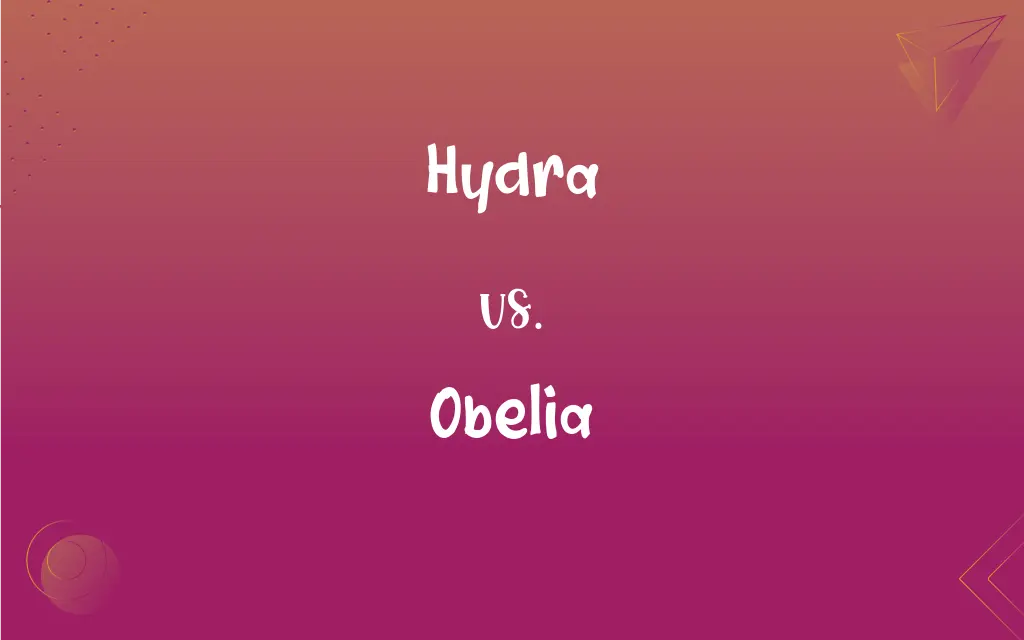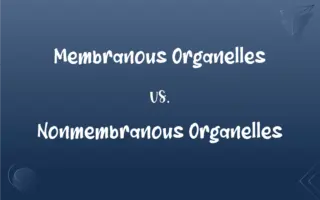Hydra vs. Obelia: What's the Difference?
Edited by Aimie Carlson || By Harlon Moss || Updated on October 19, 2023
Hydra is a freshwater cnidarian with a simple, tubular body, while Obelia is a marine cnidarian that alternates between polyp and medusa stages.

Key Differences
Hydra and Obelia are both cnidarians, a group of simple aquatic animals known for their stinging cells. Hydra is a genus of freshwater organisms with a cylindrical body and a mouth surrounded by tentacles. These organisms reproduce both asexually and sexually and do not have a medusa stage in their life cycle.
On the other hand, Obelia is a marine cnidarian that exhibits an alternating life cycle, switching between a sessile polyp form and a free-floating medusa stage. While hydra remains in a single polyp form throughout its life, obelia goes through two distinct stages, showcasing the fascinating dynamics of cnidarian development.
Furthermore, hydra's environment is limited to freshwater habitats, such as ponds and lakes. They are often studied for their regenerative capabilities, as they can reform even when segmented into pieces. Obelia, in contrast, is a marine dweller, primarily found in saltwater environments. Their life cycle is more complex than that of the hydra due to the existence of the medusa stage.
The tentacles in both hydra and obelia contain specialized cells called cnidocytes that release toxins to capture prey. However, while hydra's tentacles are used primarily for capturing prey, obelia's polyp tentacles also assist in building colonies. The medusa stage of obelia possesses tentacles for predation as well.
Comparison Chart
Habitat
Freshwater environments.
Marine environments.
ADVERTISEMENT
Life Cycle
Exists only in the polyp stage.
Alternates between polyp and medusa stages.
Reproduction
Asexual (budding) and sexual.
Asexual (budding in polyp stage) and sexual (in medusa stage).
Physical Appearance
Tubular body with tentacles surrounding the mouth.
Polyps are colonial; medusae are free-floating with tentacles.
Study Significance
Known for regenerative capabilities.
Showcases complex cnidarian life cycles.
Hydra and Obelia Definitions
Hydra
Known for its regenerative abilities.
It's fascinating how a hydra can regenerate its entire body.
ADVERTISEMENT
Obelia
Belongs to the class Hydrozoa.
Obelia is a hydrozoan, characterized by its distinct life cycle.
Hydra
A simple, freshwater cnidarian with tentacles.
I observed a hydra under the microscope in biology class.
Obelia
Produces medusae that are free-floating.
Obelia medusae drift in the water, capturing prey with their tentacles.
Hydra
A genus within the phylum Cnidaria.
Hydra belongs to the same phylum as jellyfish and corals.
Obelia
Has tentacles equipped with stinging cells.
The obelia uses its tentacles for both predation and defense.
Hydra
Lacks a medusa stage in its life cycle.
Unlike some cnidarians, the hydra doesn't develop into a medusa.
Obelia
A marine cnidarian that alternates between life stages.
Obelia exhibits both polyp and medusa forms.
Hydra
Predatory, capturing prey with stinging cells.
The hydra uses its tentacles to immobilize its prey.
Obelia
Forms colonies in its polyp stage.
The obelia polyps connect to form intricate colonies.
Hydra
Greek Mythology The many-headed monster that was slain by Hercules.
Obelia
Any of various marine hydroids of the genus Obelia that exist chiefly as colonies of polyps growing in a branchlike form on surfaces such as piers or rocks.
Hydra
(Astronomy)A satellite of Pluto.
Obelia
(zoology) Any of various colonial marine hydroids of the genus Obelia.
FAQs
Are both hydra and obelia jellyfish?
No, but both belong to the phylum Cnidaria, like jellyfish.
Which one has a more complex life cycle?
Obelia, due to its alternating polyp and medusa stages.
Are hydra immortal?
Some studies suggest certain hydra species might not undergo typical aging, but "immortal" might be an overstatement.
Do obelia sting?
Yes, obelia possess stinging cells used for capturing prey.
Is obelia found in freshwater?
No, obelia is primarily a marine organism.
Where can you find hydra?
Hydra are freshwater organisms, found in ponds and lakes.
How do hydra move?
Hydra can move using a somersaulting motion or by gliding on surfaces.
Can hydra reproduce asexually?
Yes, hydra can reproduce asexually through budding.
How large can a hydra get?
Typically, hydras are small, often less than 15mm long.
Do hydras have eyes?
No, hydras do not have eyes or specialized visual organs.
Can obelia harm humans?
While obelia can sting, their stings are generally not harmful to humans.
Are obelia polyps solitary?
No, obelia polyps form interconnected colonies.
How do hydra eat?
Hydra capture prey with their tentacles and ingest them through their mouth.
Are hydra found in saltwater?
No, hydra are exclusively freshwater organisms.
How do obelia reproduce?
Obelia reproduce asexually in the polyp stage and sexually in the medusa stage.
Is obelia a single organism?
Obelia colonies consist of many interconnected individual polyps.
What's the significance of obelia's medusa stage?
The medusa stage allows for sexual reproduction in obelia.
What do obelia feed on?
Obelia feed on small aquatic organisms using their stinging cells.
Do obelia colonies float?
Obelia polyp colonies are often attached to substrates, but the medusae are free-floating.
How do hydra defend themselves?
Hydra use their stinging cells for both capturing prey and defense.
About Author
Written by
Harlon MossHarlon is a seasoned quality moderator and accomplished content writer for Difference Wiki. An alumnus of the prestigious University of California, he earned his degree in Computer Science. Leveraging his academic background, Harlon brings a meticulous and informed perspective to his work, ensuring content accuracy and excellence.
Edited by
Aimie CarlsonAimie Carlson, holding a master's degree in English literature, is a fervent English language enthusiast. She lends her writing talents to Difference Wiki, a prominent website that specializes in comparisons, offering readers insightful analyses that both captivate and inform.































































